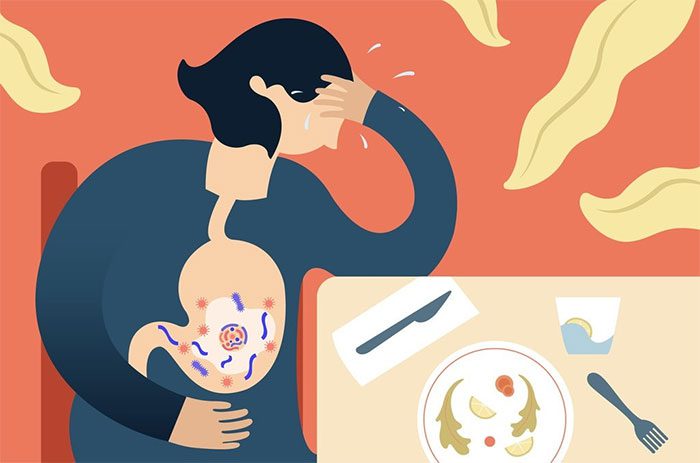Several large-scale food poisoning incidents have been reported across various regions in the country, affecting both urban and rural areas.
New Reasons Behind Increasing Food Poisoning Cases
Globally, even in the United States, which is considered to have safe food sources and strict processing protocols, there are approximately 128,000 cases of foodborne illness each year, with around 3,000 fatalities, and this trend is on the rise (according to CDC reports). This highlights that food poisoning is becoming a concerning public health issue in both developed and developing countries.
What Causes Food Poisoning?
There are many causes of food poisoning, but pathogenic bacteria are the most common culprit. These microorganisms can be bacteria, viruses, fungi, or parasites. They not only spoil food but can also directly harm human health. The pathogenic mechanisms of these microorganisms can be categorized into three main groups:
- Infection: Individuals consume food containing pathogenic bacteria, which then attack the digestive system or are poisoned by toxins produced during their growth in the intestines. For example, Salmonella bacteria were identified in a bread poisoning incident, and Staphylococcus aureus was involved in a poisoning case among preschool children.
- Toxin poisoning occurs as a result of consuming food contaminated with toxins produced by microorganisms, even when these do not invade the body. A notable case is Clostridium botulinum, an anaerobic bacterium that caused a cluster of poisoning cases from fermented salted fish in Quang Nam in March 2023.
- Foods that naturally contain toxins such as pufferfish, cassava, and poisonous mushrooms.
Thousands of microorganisms have always existed in the natural environment. Nowadays, despite advancements in modern techniques, regulated processing, and increased public awareness of food safety, large-scale food poisoning incidents continue to occur in both urban and rural areas.

Pathogenic bacteria are the most common cause of food poisoning.
This Situation Arises from New Societal Factors
1. Changes in food processing, distribution, and eating habits
Most pathogens originate from animal products (such as pork, beef, chicken, goat…) and other animal-derived products (like milk, eggs, cheese…). The consumption of these products has increased due to rapid population growth and globalization. The mass production and distribution of goods also mean that any mistakes in processing—from farm to table—can significantly increase the risk of widespread pathogen transmission. A notable example is the Salmonella outbreak in the U.S. in 2010, which resulted in 272 cases across several states linked to Italian sausage, caused by a contaminated batch of pepper from an Asian company.
Consumer habits have also shifted toward prioritizing protein-rich foods, with increased dining out, a preference for fast food, and the use of processed foods high in fats and sugars, such as canned goods, smoked foods, and vacuum-sealed products. These nutritious foods provide an ideal environment for pathogenic microorganisms to thrive, such as E. coli commonly found in unpasteurized dairy products and fruit juices, ground beef; Clostridium botulinum in canned or vacuum-sealed products; and Salmonella in undercooked meat, eggs, cheese, seafood, fresh fruits, and vegetables.
2. The emergence of new pathogens and changing transmission methods
According to information from the National Institutes of Health website in April 2023, trends in food production and distribution, along with modern processing, have led to the emergence of new pathogens such as Listeria monocytogenes. This bacterium is commonly found in products like sausages, cold cuts, soft cheese made from unpasteurized milk, ham salad, chicken salad, and smoked seafood.
Intensive livestock farming (which means raising multiple types of livestock in a small area for a short period) has led to the emergence of various Salmonella serotypes.
The use of biofilm production (which can include food wrapping) contributes to the entry of pathogens into food.
3. Antibiotic resistance in foodborne pathogens
Climate change and agricultural practices, such as the use of pesticides, plant growth enhancers, organic waste as fertilizer, and the use of antibiotics in livestock, have led to antibiotic resistance. As a result, pathogenic bacteria do not get eliminated and continue to thrive. Cases of multidrug-resistant Salmonella have been reported and pose a threat to food safety. Individuals infected with antibiotic-resistant bacteria may experience more severe illness and have fewer treatment options.
Risk Factors for Food Poisoning
Age over 65: The increasing population and longer life expectancy raise the number of individuals at risk. As the body ages, the immune system and organs lose their ability to recognize and eliminate pathogenic microorganisms.
Children under 5 years: Due to their immature immune system, children are less capable of fighting off pathogens. They are more susceptible to illness because of their high consumption of meat, dairy, eggs, and cheese, along with a lack of personal hygiene awareness. Food poisoning can lead to diarrhea and dehydration, making children vulnerable to kidney failure and rapid deterioration if not treated promptly.
Individuals with chronic illnesses: Such as diabetes, alcoholism, liver disease, kidney failure, prolonged use of corticosteroids, or cancer patients undergoing radiation or chemotherapy… These individuals are increasingly prevalent in the population and are more susceptible to food poisoning due to compromised immune systems.
Pregnant women: Pregnancy brings changes in metabolism and increased demand for diverse foods. The early symptoms of food poisoning can often be mistaken for morning sickness. Therefore, this group also needs to be cautious about their eating habits.
Through the analyses above, we can see that food poisoning is currently a challenging issue for countries worldwide, raising many new concerns. Enhancing healthcare capacity and tightly managing food production processes will help mitigate large-scale food poisoning incidents. Individuals should proactively seek to understand and implement measures including “Clean – Separate – Cook – Chill” to protect their health and that of their families.





















































